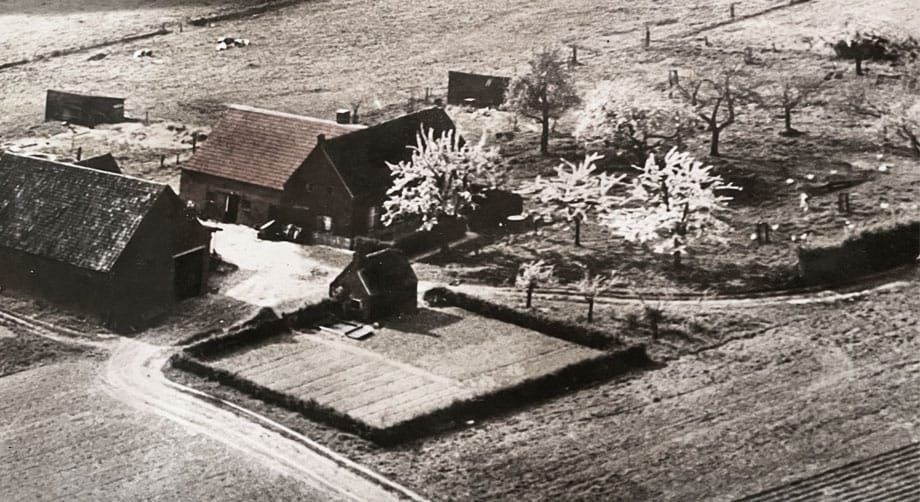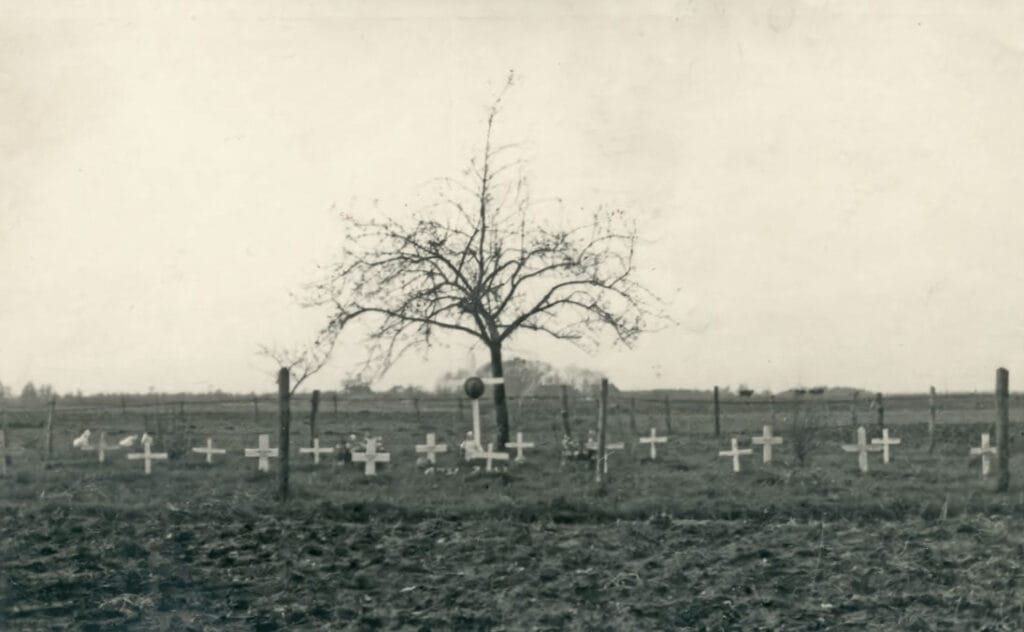Chambers | Percy
- First names
Percy
- Age
29
- Date of birth
1915
- Date of death
19-10-1944
- Service number
5116538
- Rank
Private
- Regiment
King’s Own Scottish Borderers, 1st Bn.
- Grave number
II. B. 13.


Biography
Percy Chambers was killed in action on 19 October 1944 near Overloon. He was a Private in the King’s Own Scottish Borderers, 1st Battalion. (Service number 5116538). He was initially buried at Cemetery A. vd Wijst in Overloon and reburied on 13 May 1947 in grave II.B.13. at the CWG Cemetery Overloon.
Family background
Percy was the son of William Arthur Chambers and Caroline S Chambers (nee Hillier). He had a twin brother called Reginald, an older sister called Edith and an older brother called Leslie.
He was married to Lilian Cecilia Ruth Colbourne on 14th November 1942 in The Parish Church, Selly Hill, Birmingham.
Military career
It is currently unclear when Percy joined the King’s Own Scottish Borderers 1st Bn.
In June 1944 the regiment was in northern France after the D-Day landings in Normandy. They played a role in Operation Goodwood in July, as part of the larger Battle of Caen.
The battalion saw action on 9 August at Vire, but was held in reserve during the attacks on Tinchebray. From 20 August to 3 September, they underwent a period of training. From 5 to 16 September, they were in Etrepangy, where they rested again and received another 30 men as reinforcements, in addition to the six officers and 91 men they had already received since D-Day.
They then moved quickly via Brussels and Leuven to support the 2nd Battalion of the Royal Ulster Rifles and the 2nd Battalion of the Lincolnshire Regiment in crossing the Meuse-Scheldt Canal and continuing on to Belgium and the Netherlands, where they reached Milheeze on 28 September.
At this point, the war diary mentions that the bath unit arrived and ‘the entire battalion felt clean for the first time since Etrepagny,’ which was more than three weeks earlier. On 1 October, they reached St Hubert, where they were very well received by the inhabitants. They remained there until 12 October. They spent their time training, but also had time for relaxation.
A football match was organised against the 6th battalion of the regiment on the football field in St Hubert. They lost 4-1 and the Pipe Band played during half-time and after the match. On 10 and 11 October, there were also two film screenings. The diary states that on 12 October, after a pleasant stay of ten days, they left St Hubert.
On 12 October, they reached a staging area just west of Sint Anthonis. That day, the 1st Suffolks managed to capture Overloon and take up a position just south of the town. The next day, the 1st KOSB attacked the forest southwest of Overloon and reached the southern edge of the forest, although it came under fire when it arrived there. They remained there the next day, while the Royal Ulster Regiment and the Lincolns attacked the forest further to the east.
On the 15th, they moved slightly further south and on the 16th they continued their advance south, expecting to remain there that night. Instead, they were ordered to relieve the 4th Battalion King’s Shropshire Light Infantry east of Overloon in the area near Smakt, with the companies forming up in a north-south direction west of the railway line. They did not take up their positions until 7.30 p.m., in very heavy rain, which meant that the reconnaissance units could hardly see their positions before dark. On 17 October, the war diary mentions that the battalion suffered the heaviest shelling with grenades and mortars to date. They spent their time patrolling the area west of the railway line and keeping an eye on enemy positions. The heavy shelling continued on 18 and 19 October. On the 19th, the war diary mentions successes in combating enemy activities by means of artillery fire and establishing an Observation Post in a farm called “Hoeve de Knol”. However, this was the day that, very near to this farm, Percy Chambers was killed.
Along with Percy, Edward Fenn, William Cluett, and Thomas Wilson, comrades from the same regiment, also died that day.
Our foundation received a letter from Edward Fenn’s family, clearly describing the dramatic events of that day. The sergeant described in the letter is most likely Thomas Wilson and the two others William Cluett and Percy Chambers. The graves concentration reports of these servicemen support this belief.
An excerpt from this letter:
“We were fighting the Germans in a very large forest and managed to drive them from it out into the open country so our company stayed at that for a rest. The Germans were out into the open on a railway bank and we were in the forest. On the end of the forest facing the Germans was a farm yard and in there was the platoon which Ted (Edward Fenn) was in.
On the morning of the 19 Oct at 10 o’clock Ted was ordered to take a patrol from the farm yard to a certain spot out in the open, in which he started to do as he gets well into the open he saw a gang of Germans coming towards him, and he at once told his men to get down a keep still as he was going to wait until the Germans where near and then try and take them all prisoners, well, everything was going fine and when the Germans got near, then things became to happen, one of the men lost his nerve and jumped up and ran away, it was then that panic broke out among the men and one more man ran away leaving Ted with two men, and three men against a gang of Germans was hope-less and there fore there was only one thing to do every man for himself, and as the three heroes got up two were killed, and Ted was seen running holding his stomach.
Meanwhile the first man who ran away was running and falling over trying to get back to the farm house, and a sergeant run out to meet him and as he did, he was shot by a machine gun and killed at once. All the time this was going on our machine gun from the house was firing at the Germans, who at once aimed their gun on to the farm house, it was then Bill (another comrade), got a bullet in the left arm, and a man standing next to him got hit in the groan.
The first man to run away reached the farm house ok, at that time we who was at H.Q at the time had got the news of what had happened, and straight away a rescue party formed to try and get the dead and wounded in. We managed to get the men from the farm in but as we try’d to get the dead sergeant and Ted in (who we thought was still alive) we was fired on by the Germans, it was then the officer said it was hope-less and we would have to wait until night came. Dark-ness came and out went the rescue party we found the sergeant and brought him in as 3 hours later we made up our minds to have the 3rd attempt to get Ted in and at 10.30 that night we found him, dead.”
The next day on 20 october 1944 they were buried in a field grave at Begraafplaats A. vd Wijst in Overloon and later, close to each other, reburied on 13 May 1947 at Overloon War Cemetery.
The full letter can be read in the biography of Edward Fenn.


Sources and credits
Sarah Endicott for the photos and explanations on Findagrave.com
This biography was partly compiled by our Foundation based on our own research and stories from other soldiers who served in the same regiment or participated in the same battle on that day. Some of the collective work within the foundation was used for this purpose.
Research Anny Huberts
